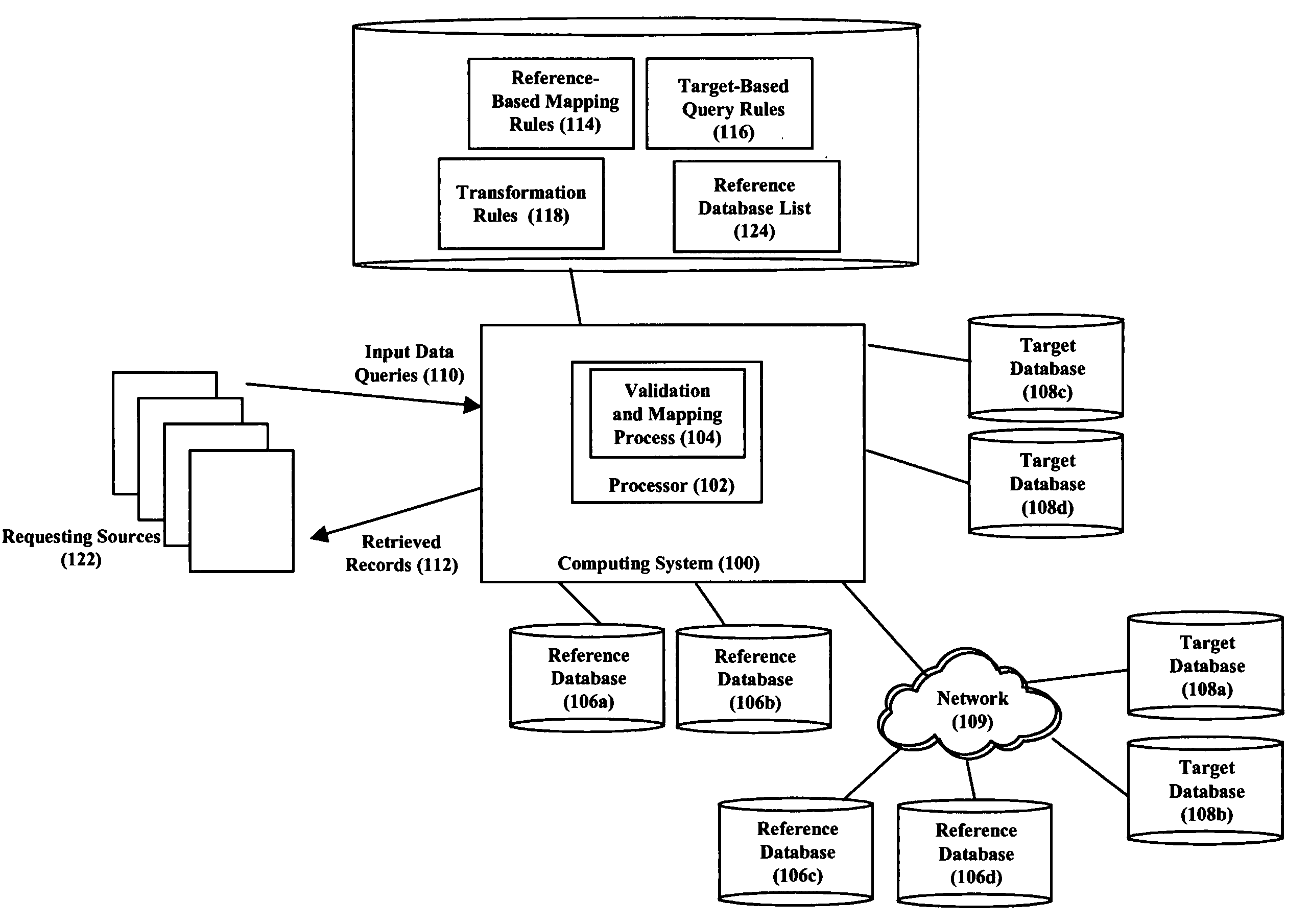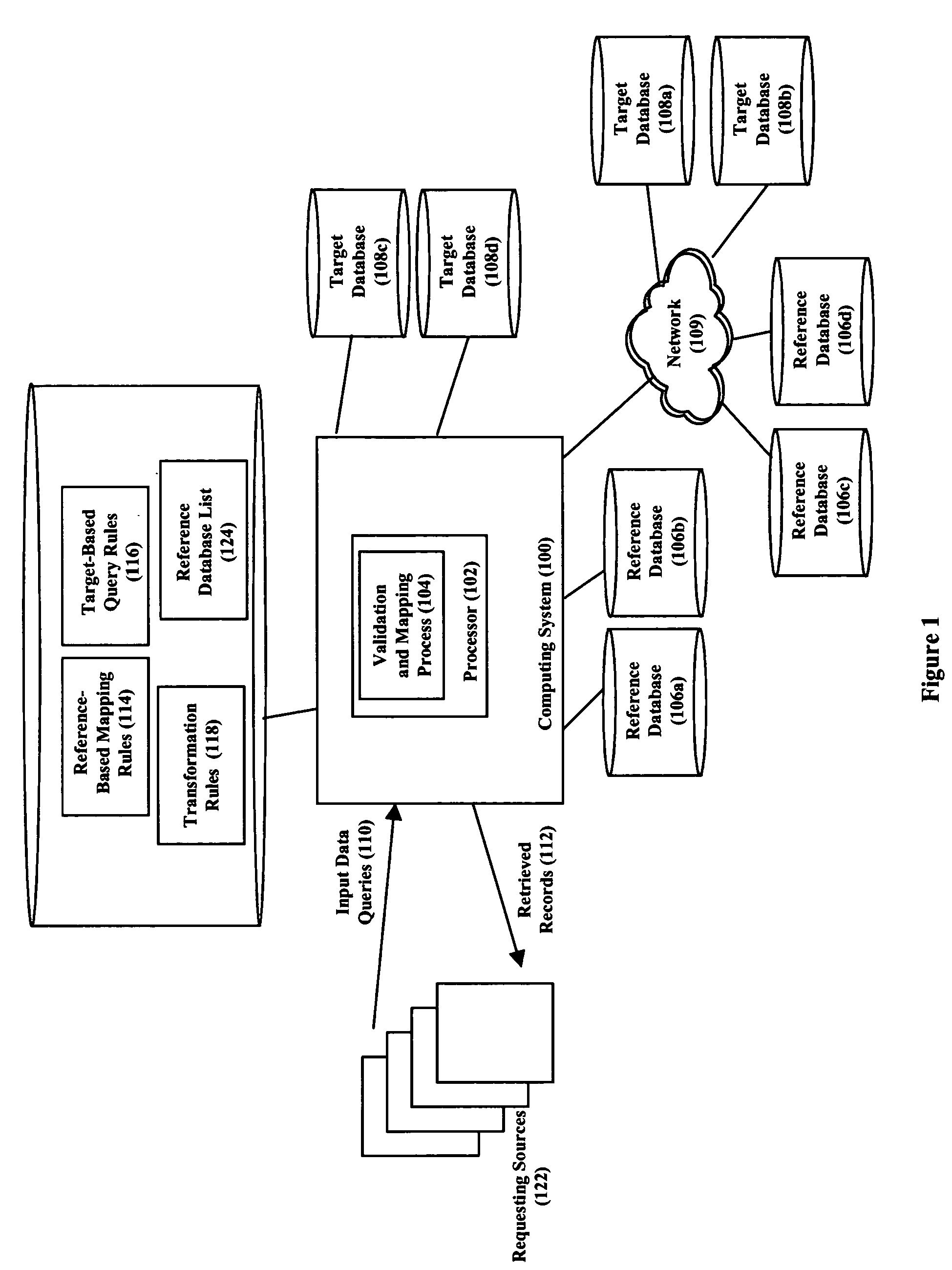Two-stage data validation and mapping for database access
a database and data validation technology, applied in the field of database access, can solve problems such as errors/imperfections and inconsistencies, contain errors, imperfections, and inconsistencies, and achieve the effect of reducing the number and complexity of rules, improving the efficiency and reliability of these database accesses
- Summary
- Abstract
- Description
- Claims
- Application Information
AI Technical Summary
Benefits of technology
Problems solved by technology
Method used
Image
Examples
first embodiment
[0020]FIG. 2 is a flow chart depicting the method steps of our invention for querying one or more of the plurality of target databases 108 with input data queries 110 from any of the plurality of requesting sources 122. In particular, upon receiving an input data query from a requesting source 122 (step 202), the input data is first validated to ensure it is complete, non-ambiguous, and correct / free of errors. Specifically, in step 204 a reference database 106 is first selected based on the type of input data. A reference database is a database that is presumed to be relatively static and has been carefully cleansed thereby making the reference database relatively accurate as compared to the target databases 108. (Note that the cleansing of the reference databases is a process that occurs outside the scope of our invention and the method steps of FIG. 2 presume this cleansing has already occurred. Note further that while the cleansing process may be processor intensive, the results ...
second embodiment
[0031] Reference will now be made to several alternative embodiments of our invention. Specifically, in accordance with our invention, in step 204 multiple reference databases 106 (rather than one) are selected based on the type of input data. Once selected, the multiple reference databases can be subsequently used in one of several alternative ways in step 206 for validating the input data As a first alternative, the multiple reference databases can be queried sequentially until either an exact matching record is found (in which case the method proceeds to step 208) or no matching records are found (in which case the method proceeds to step 210). Alternatively, the “reference-based mapping rules”114 preferably also include partial mapping rules such that the sequential queries also result in one or more possibly near-matching records being found. When such near-matching records are collected and no matching record is found, the method proceeds to step 212 where a determination is m...
third embodiment
[0034] In accordance with our invention, multiple canonical forms of the input data are used to search each target database (i.e., each target database is searched multiple times, each time using a different canonical form of the input data). The multiple canonical forms of the input data can be obtained in several ways. For example, a single reference database can be queried in step 206 and the resulting record then expressed in different ways in step 208 based on the “transformation rules”118. Alternatively, multiple reference databases can be queried in step 206 and each resulting record then used to generate a canonical form of the input data. For example, given an address as input data, a reference database of addresses can be queried to give an address-based canonical form of the input data and a reference database of latitudes / longitudes can be queried to give a latitude / longitude canonical form of the input data. Regardless, each of the canonical forms of the input data is t...
PUM
 Login to View More
Login to View More Abstract
Description
Claims
Application Information
 Login to View More
Login to View More - R&D
- Intellectual Property
- Life Sciences
- Materials
- Tech Scout
- Unparalleled Data Quality
- Higher Quality Content
- 60% Fewer Hallucinations
Browse by: Latest US Patents, China's latest patents, Technical Efficacy Thesaurus, Application Domain, Technology Topic, Popular Technical Reports.
© 2025 PatSnap. All rights reserved.Legal|Privacy policy|Modern Slavery Act Transparency Statement|Sitemap|About US| Contact US: help@patsnap.com



